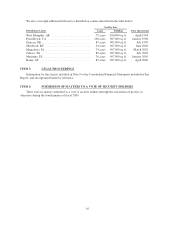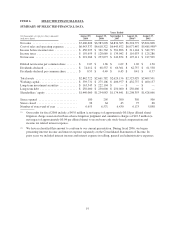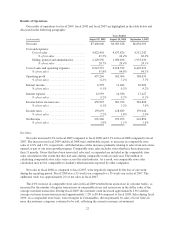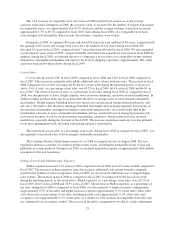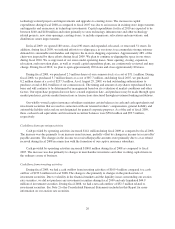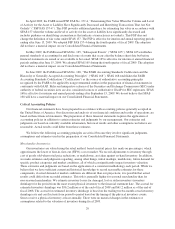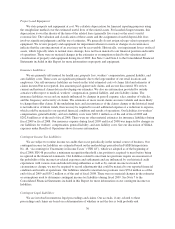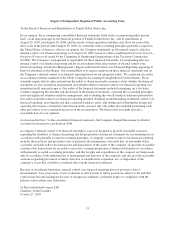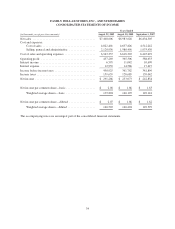Family Dollar 2009 Annual Report Download - page 33
Download and view the complete annual report
Please find page 33 of the 2009 Family Dollar annual report below. You can navigate through the pages in the report by either clicking on the pages listed below, or by using the keyword search tool below to find specific information within the annual report.Credit Facilities
On December 18, 2008, we entered into an unsecured revolving credit facility with a syndicate of lenders
for short-term borrowings of up to $250 million. The credit facility replaced our $250 million unsecured
revolving credit facility that was scheduled to mature on January 29, 2009. The credit facility has an initial term
of 364 days and includes two one-year extensions that require lender consent. The credit facility also includes a
one year term-out option that does not require lender consent. Any borrowings under the credit facility accrue
interest at a variable rate based on short-term market interest rates.
We also maintain a $350 million unsecured revolving credit facility expiring on August 24, 2011. Any
borrowings under this credit facility also accrue interest at a variable rate based on short-term market interest
rates. Outstanding standby letters of credit ($202.3 million as of August 29, 2009) reduce the borrowing capacity
of the $350 million credit facility.
There were no borrowings under the credit facilities during fiscal 2009, compared with $736.3 million
borrowed and repaid in fiscal 2008. The credit facilities contain certain restrictive financial covenants, which
include a consolidated debt to consolidated capitalization ratio, a fixed charge coverage ratio, and a priority debt
to consolidated net worth ratio. As of August 29, 2009, we were in compliance with all such covenants.
Notes
On September 27, 2005, we obtained $250 million through a private placement of unsecured Senior Notes
(the “Notes”) to a group of institutional accredited investors. The Notes were issued in two tranches at par and
rank pari passu in right of payment with our other unsecured senior indebtedness. The first tranche has an
aggregate principal amount of $169 million, is payable in a single installment on September 27, 2015, and bears
interest at a rate of 5.41% per annum from the date of issuance. The second tranche has an aggregate principal
amount of $81 million, matures on September 27, 2015, with amortization commencing in the sixth year, and
bears interest at a rate of 5.24% per annum from the date of issuance. The second tranche has a required principal
payment of $16.2 million on September 27, 2011, and on each September 27 thereafter to and including
September 27, 2015. Interest on the Notes is payable semi-annually in arrears on the 27th day of March and
September of each year. The sale of the Notes was effected in transactions not requiring registration under the
Securities Act of 1933, as amended. The Notes contain certain restrictive financial covenants, which include a
consolidated debt to consolidated capitalization ratio, a fixed charge coverage ratio, and a priority debt to
consolidated net worth ratio. At the end of fiscal 2009, we were in compliance with all such covenants.
Other Considerations
Our merchandise inventories at the end of fiscal 2009 were 3.8% lower than at the end of fiscal
2008. Inventory per store at the end of fiscal 2009 was approximately 5.0% lower than inventory per store at the
end of fiscal 2008. The decrease in total inventory and inventory per store during fiscal 2009 was due to a
decrease in discretionary merchandise. During fiscal 2009, we reduced our purchases of discretionary
merchandise and focused on meeting higher customer demand for consumable merchandise.
Our merchandise inventories at the end of fiscal 2008 were 3.1% lower than at the end of fiscal 2007.
Inventory per store at the end of fiscal 2008 was approximately 5.2% lower than inventory per store at the end of
fiscal 2007. The decrease in total inventory and inventory per store during fiscal 2008 resulted from efforts to
improve our inventory productivity, including the continuation of an aggressive markdown strategy that began in
fiscal 2007.
Capital expenditures for fiscal 2009 were $155.4 million compared with $167.9 million in fiscal 2008 and
$131.6 million in fiscal 2007. The decrease in capital expenditures during fiscal 2009 as compared to fiscal 2008
was due primarily to a decrease in distribution and corporate office related projects, which offset increases in
25



